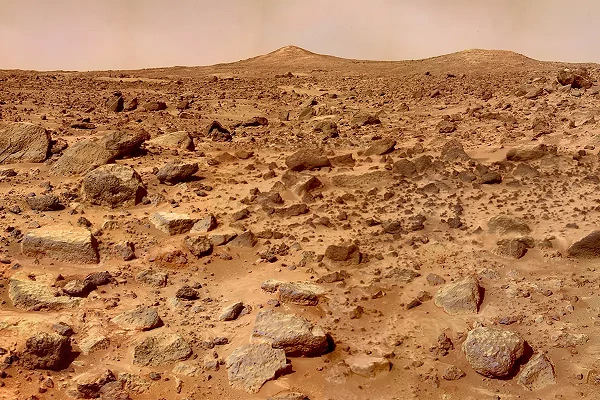Martian rock-metal composite shows potential of 3D printing on Mars
Women prefer not to participate in competitive situations when making decisions for themselves, study finds / Some screen time before bedtime may, in fact, be safe for sleep
The components were created by researchers at Washington State University using anywhere from 5% to 100% Martian regolith, a black powder meant to resemble the rocky, inorganic material found on the surface of the red planet. While the components with 5% Martian regolith were robust, those with 100% regolith were brittle and easily cracked. Still, even materials with a high Martian content could be used to create coatings that protect equipment from rust or radiation damage.
A small amount of Martian dust seems to go a long way. In a 3D printing process, a small amount of simulated crushed Martian rock combined with a titanium alloy produced a stronger, high-performance material that could one day be used to create tools or rocket parts on Mars.
The components were created by researchers at Washington State University using anywhere from 5% to 100% Martian regolith, a black powder meant to resemble the rocky, inorganic material found on the surface of the red planet.

Martian rock-metal composite shows potential of 3D printing on Mars (Illustrative image).
While the components with 5% Martian regolith were robust, those with 100% regolith were brittle and easily cracked. According to Amit Bandyopadhyay, the corresponding author of the study published in the International Journal of Applied Ceramic Technology, even materials with a high Martian content could be used to create coatings that protect equipment from rust or radiation damage.
"In space, 3D printing is something that has to happen if we want to think of a manned mission because we really cannot carry everything from here," said Bandyopadhyay, a professor in WSU's School of Mechanical and Materials Engineering. "And if we forgot something, we cannot come back to get it."
Transporting materials into space can be very costly. The authors noted that it costs approximately $54,000 for the NASA space shuttle to place one kilogram (about 4.4 pounds) of payload into Earth orbit. Anything that can be manufactured in space or on Earth would save weight and money, and if something breaks, astronauts would need to be able to fix it on site.
NASA's Bandyopadhyay demonstrated the viability of this concept for the first time in 2011 when his team used 3D printing to create components from lunar regolith, a simulation of crushed moon rock. Since then, space agencies have embraced the technology, and the International Space Station is equipped with its own 3D printers for on-site material production and experimentation.
Bandyopadhyay, along with graduate students Ali Afrouzian and Kellen Traxel, utilized a powder-based 3D printer to combine the simulated Martian rock dust with a titanium alloy, a metal frequently used for space exploration due to its strength and heat-resistance. As part of the procedure, a powerful laser heated the materials to temperatures in excess of 2,000 degrees Celsius (3,632 F). The molten mixture of Martian regolith-ceramic and metallic material was then poured onto a movable platform, allowing the scientists to create various sizes and shapes. After the material had cooled, strength and durability tests were conducted.
The ceramic material made from 100% Martian rock dust cracked as it cooled, but as Bandyopadhyay pointed out, cracks are irrelevant in the context of radiation shield coatings. The mixture containing 5% regolith, however, not only did not crack or bubble, but also exhibited better properties than titanium alloy by itself, meaning it could be used to create lighter weight pieces that could still withstand heavy loads.
"It gives you a better, higher strength and hardness material, so that can perform significantly better in some applications," he said. According to Bandyopadhyay, this study is only the beginning, and future research may produce better composites using different metals or 3D-printing techniques.
"This establishes that it is possible, and maybe we should think in this direction because it's not just making plastic parts which are weak but metal-ceramic composite parts which are strong and can be used for any kind of structural parts," he said.
Journal Reference: Ali Afrouzian, Kellen D. Traxel, Amit Bandyopadhyay. Martian regolith—Ti6Al4V composites via additive manufacturing. International Journal of Applied Ceramic Technology, 2022; DOI: 10.1111/ijac.14136
End of content
Không có tin nào tiếp theo
